Abstract
Bioremediation is a promising technique owing to its effectiveness, low cost, and environmental friendliness. Previous studies have focused on the degradation efficiency of polycyclic aromatic hydrocarbons (PAHs) in soil and water. However, the expression of PAH-catabolic genes in organisms involved in the degradation process has been rarely and unsystematically reported. In this study, a PAH-degrading strain—Pseudomonas aeruginosa (PQ249631)—was successfully isolated from coking-contaminated soil and used for PAH degradation in soil and water. Furthermore, the degradation of PAHs (naphthalene, fluorene, phenanthrene, anthracene, and pyrene) was investigated in single, binary, and mixture systems to explore the interaction of substrates. The results showed that when naphthalene was used as a cometabolite carbon source, the removal rates of fluorene, phenanthrene, anthracene, and pyrene increased from 14.33%, 17.25%, 6.61%, and 4.47% to 72.08%, 100.00%, 15.63%, and 6.63%, respectively. In a PAH mixture, the degradation rate of each PAH was higher when naphthalene, rather than glucose, was used as the cometabolite carbon source. Transcriptome analysis revealed significant differential expression of PAH-catabolic genes and ATP-binding cassette transporter-related genes under naphthalene stress. The enhanced degradation of PAHs could be attributed to the augmentation of the PAH metabolic pathway and membrane transportation, facilitating the transfer of PAHs to bacteria. These findings underscore the effectiveness of P. aeruginosa as a PAH degrader and provide molecular insights into enhancing PAH degradation.
1. Introduction
Polycyclic aromatic hydrocarbons (PAHs) constitute a class of persistent and toxic organic pollutants in the environment that exert strong mutagenic, teratogenic, and carcinogenic effects on humans [1,2]. They are ubiquitous in the environment, relatively difficult to degrade, and may accumulate in the human body, thereby increasing the number of patients with cancer related to PAHs as well as the global burden of death and disease [3,4]. Therefore, developing methods to efficiently remediate PAH pollution is crucial. Compared with conventional physical and chemical remediation techniques, bioremediation has several advantages, including low cost, sustainability, environmental friendliness, and in situ remediation [5,6,7,8]. The prospect of microbial degradation has been widely investigated. Numerous plants, microbes, and some lower eukaryotes may participate in the biodegradation process [9,10,11,12,13,14]. A large number of microbes, including bacteria, fungi, algae, and cyanobacteria, can use various PAHs, such as naphthalene, phenanthrene, acenaphthene, anthracene, fluoranthene, pyrene, and chrysene, as a sole carbon and energy source or through cometabolism with other carbon sources, resulting in the conversion of PAHs into less complex and less toxic metabolites [5,8,15,16,17,18].
For biodegradation of PAHs, screening for functional degrading microorganisms is critical. Typically, PAH-degrading microorganisms originating from contaminated soil or sediment exhibit greater efficiency in utilizing these pollutants, whereas artificially introduced microbes face significant constraints and tend to compete with a low survival rate [19,20]. Bacteria are the primary microorganisms involved in the remediation of PAHs, and various bacterial species, including Pseudomonas, Bacillus, Nocardia, Sphingomonas, Mycobacterium, Acinetobacter sp., Pontibacillus, and Alcaligenes, are known to degrade PAHs [18,21,22]. Bacteria can metabolize PAHs anaerobically and aerobically [23], and aerobic degradation has been extensively reported. Although anaerobic degradation proceeds at a slower rate and has many limitations, it has a distinct advantage of being applicable to certain special natural environments [21,24]. For aerobic degradation of PAHs, dioxygenase hydrolyzes the aromatic ring to form cis-dihydrodiol compounds, which are transformed into dihydroxylated intermediates by dehydrogenase and further metabolized into phthalic acid and salicylic acid. They undergo metabolism via the TCA cycle and are fully mineralized into carbon dioxide and water [25]. The genus Pseudomonas encompasses numerous aerobic bacteria capable of degrading PAHs and constitute 86.9% of the hydrocarbon-degrading microorganisms identified in gasoline-contaminated aquifers [1,26]. Some bacteria from the genus Pseudomonas, which specialize in degrading PAHs, can produce biosurfactants. Inoculation with such bacteria enhances the bioavailability of PAHs [26,27,28].
Microbial degradation refers to the ability of microorganisms to transfer the toxic and harmful substances such as PAHs into harmless ones based on their growth and metabolic processes, and the remediation period can be relatively long [18,29]. The rate of PAH degradation can be increased through biostimulation with an amended carbon source [24]. The introduction of pyruvate as a carbon source significantly stimulated microbial growth and accelerated the rate of PAH degradation [30]. Notably, this process did not lead to diauxic growth. Instead, biostimulation with pyruvate facilitated the rapid adaptation of P. putida G7 to naphthalene and enhanced the efficiency of in situ bioremediation [30]. Naphthalene, the most basic PAH, can be used by various bacteria as their sole carbon source for growth. It is also commonly employed as a cometabolic substrate to enhance the microbial degradation of other PAHs. Biostimulation with naphthalene resulted in a fivefold increase in phenanthrene degradation and a twofold enhancement in pyrene degradation by Pseudomonas putida KBM-1 [31]. Pyrene degradation by a fusant bacterial strain F14 could be enhanced by naphthalene and phenanthrene [16]. Based on a previous study, the degradation efficiency of acenaphthene, fluorene, phenanthrene, anthracene, and pyrene increased significantly when they were mixed. Furthermore, the availability of a richer carbon source in the mixture of these five compounds enhanced the degradation results, thus promoting a more efficient breakdown [20]. However, the interaction of substrates within a mixture could affect the biodegradation of PAHs by both pure and combined cultures [3,21,24,29]. Stringfellow and Aitken reported that the presence of naphthalene, methylnaphthalene, and fluorene in the binary mixtures results in competitive inhibition of phenanthrene degradation by P. stutzeri [32,33]. The biodegradation of anthracene by Rhodococcus spp. and biodegradation of pyrene by M. flavescens are inhibited by the presence of fluoranthene and phenanthrene [17,31,34]. Several studies have shown that substrate interaction does not exert a significant influence on the degradation process. For example, Tsai et al. reported that sulfate-reducing bacteria can effectively degrade fluorene and phenanthrene without any observable inhibitory effects [35]. As multiple PAHs coexist in actual contamination sites, PAH biodegradation cannot be processed separately for complicated interactions. Therefore, it is necessary to determine the effect of substrate interactions on the biodegradation of PAHs, which is beneficial for the removal of these pollutants.
Most studies have focused on the growth of functional bacteria, activity of several enzymes, and identification of the related genes involved in the degradation process but have not conducted analysis of PAH-catabolic gene expression [20,22,24,28]. However, there is little information regarding the relationship between the phenotypes and genotypes. Degradation of PAHs depends on adaptation of microbes through the regulation of gene expression induced by exposure to contaminants. In this study, transcriptome sequencing was used to assess changes in the expression of Pseudomonas genes induced by naphthalene stress to identify the potential molecular mechanism by which naphthalene enhances the degradation of other PAHs. A PAH-degrading bacterium from coking-contaminated soil was isolated and characterized. The effects of naphthalene as a cometabolite carbon source on the degradation profile and degradation-related enzyme activity of the strain were also examined. In addition to transcriptomic analysis, the fundamental mechanisms that facilitate the enhanced biodegradation of PAHs by naphthalene were determined, providing insights into the biological processes involved.
Overall, the objectives of this study were to (1) isolate a PAH-degrading bacterium from a coking-contaminated site; (2) examine the effects of the coexisting substrate naphthalene on the degradation of PAHs; and (3) examine the transcriptomic response of the strain in the presence of various carbon sources, including glucose and naphthalene. This study provides a theoretical basis for further studies on in situ remediation of PAHs in soil and water.
2. Materials and Methods
2.1. Chemicals and Culture Media
Acetone, naphthalene, fluorene, phenanthrene, anthracene, and pyrene were purchased from Aladdin Bio-Chem Technology Co., Ltd. (Shanghai, China). All organic solvents used for the experiments were of high-performance liquid chromatography (HPLC) grade, and inorganic chemicals were of analytical grade or higher. The culture medium mineral salt medium (MSM) was composed of KH2PO4 (1.0 g/L), K2HPO4 (0.5 g/L), (NH4)2SO4 (1.65 g/L), CaCl2 (0.02 g/L), MgSO4·7H2O (0.5 g/L), FeCl3·6H2O (0.02 g/L), and trace element solution 1 mL, and the pH was adjusted to 7.0. The medium was sterilized at 121 °C and 0.103 MPa for 20 min.
PAH preparation: Solutions of naphthalene (100 g/L) as well as fluorene, phenanthrene, anthracene, and pyrene (each at 5 g/L) were prepared in acetone. They were filter-sterilized through a sterile organic filter (pore size, 0.22 μm) to remove bacteria and were added to the degradation system at the desired concentration after the completion of acetone volatilization.
2.2. Enrichment, Isolation, and Identification of PAH-Degrading Bacteria
PAH-degrading bacteria were isolated from PAH-contaminated soil at a coking site located in Taiyuan (coordinates: 112°30′4′′ E, 37°50′29′′ N), Northern China. This site is a former coking plant where various PAHs, including naphthalene, fluorene, phenanthrene, anthracene, pyrene, fluoranthene, and benzo(a)pyrene, etc., can be detected in the soil. Aged contaminated soil (10 g) was added into a 250-mL flask containing 100 mL of sterilized MSM for 8 h at 30 °C. Subsequently, 10 mL of the supernatant was taken and transferred into fresh MSM medium containing 50 mg/L naphthalene. The flask was incubated in a shaking incubator (150 rpm) for 7 days at 30 °C. The enrichment procedure was repeated thrice [3].
To selectively isolate the bacteria, 0.1 mL of the enriched cultures were spread onto MSM agar plates precoated with a thin layer of naphthalene (50 mg/L). The plates were incubated at 35 °C in the incubator for 7 days. Bacterial colonies with prominent growth and surrounded by clear zones were isolated and repeatedly subcultured to ensure culture purity. The isolated bacterial colony was selected and preserved as a glycerol stock (20% v/v) at −80 °C.
Identification of PAH-degrading strains was performed based on the results of 16S ribosomal DNA (rDNA) sequencing, which was conducted by Meige Gene Technology Co., Ltd. (Shanghai, China). The sequences were analyzed using the NCBI database for alignment. The 16S rDNA data can be used to develop a phylogenetic tree using the neighbor-joining method.
2.3. Degradation of PAHs in a Single, Binary, and Mixture Systems
To examine the degradation of PAHs, 5 mL of AO-1 bacterial solution (OD600 = 1) in the logarithmic growth phase was inoculated into 100 mL of MSM containing 50 mg/L naphthalene, fluorene, phenanthrene, anthracene, and pyrene, respectively. The binary or mixed degradation systems were reconstituted by simultaneously adding the individual PAH stock solutions into the MSM. In the mixture system, the amount of carbon in glucose and sodium acetate (SA) was equivalent to that in naphthalene. The sterilized flasks containing PAHs without bacteria were used as controls. All flasks were incubated on a rotary shaker (150 rpm) at 30 °C for 5 days (fluorene and phenanthrene) or 20 days (anthracene, pyrene, and a mixture of them). Samples were periodically collected. At each sampling time, triplicate flasks were used to determine the PAH and bacterial concentrations (OD600).
2.4. Determination of PAH Concentration and Calculation of the Degradation Rate
The samples were extracted with an equal volume of ethyl acetate, placed on a shaker at 1500 rpm for 5 min, sonicated for 10 min, and centrifuged at 10,000 rpm for 5 min to separate the organic and aqueous phases. The organic ethyl acetate extract was filtered through an organic filter membrane with a pore size of 0.22 μm. The concentration of each PAH was determined via HPLC. The conditions for HPLC were as follows: a ZORBAX Eclipse PAH column (Agilent, Santa Clara, CA, USA), UV detector (Agilent, Santa Clara, CA, USA), column temperature of 30 °C, mobile phase of methanol and water, flow rate of 1 mL/min, injection volume of 20 μL, and detection wavelength of 220 nm [6].
The degradation rate η was calculated based on the following formula: η = (C0 − C)/C0 × 100%, where C0 is the initial concentration of PAHs and C is the final concentration after degradation.
2.5. Determination of Dehydrogenase Activity
The dehydrogenase activity of microorganisms was measured using a spectrophotometer [6]. Briefly, 2 mL of the bacterial suspension, 2 mL of Tris-HCl buffer solution (pH 8.5, 0.05 mol/L), 2 mL of 0.10 mol/L glucose solution, and 2 mL of 0.5% (m/m) 2,3,5-triphenyltetrazolium chloride (TTC) were added to a test tube and then incubated at 30 °C for 4 h under dark conditions. Subsequently, 0.4 mL of concentrated sulfuric acid was added to stop the reaction. Further, 5 mL of toluene was added for extraction, and the tubes were shaken for 5 min. When the generated red triphenylmethane (TF) was completely extracted into the organic phase, the extracts were measured spectrophotometrically at 485 nm.
2.6. Oil Spreading Test
An oil spreading test was used to determine the diameter of the clear zone induced by a drop of the biosurfactant solution. Distilled water (20 mL) was poured onto a petri dish (15 cm), followed by the addition of 10 µL of olive oil to the surface of the water [36]. A drop of the cell-free culture supernatant was added to the center of the oil film. Distilled water was used as a control.
2.7. Transcriptome Analysis
Bacterial cells were collected after PAH degradation and stored at −80 °C for RNA sequencing. Library construction and sequencing were performed by Meige Gene Technology Co., Ltd. (Shanghai, China). Total RNA was extracted from the sample using Trizol reagent (Invitrogen, Carlsbad, CA) as per the manufacturer’s instructions. Transcriptome sequencing was performed using the Illumina high-throughput sequencing platform NovaSeq PE 150. The sequencing data were compared with the reference genome using Bowtie2. Subsequently, the differential expression analysis of the genes was conducted using edgeR software (https://cloud.majorbio.com/page/tools.html accessed on January 2023). Genes with an adjusted p-value of <0.05 and |log₂FC| value of ≥1 (FC: fold change, representing the ratio of expression levels between the two groups of samples) were considered differentially expressed genes (DEGs). Genes enriched in specific pathways were subjected to Kyoto Encyclopedia of Genes and Genomes (KEGG) and Gene Ontology (GO) analyses.
2.8. Statistical Analysis
All data, except for high-throughput sequencing results, were obtained in triplicate and presented as the mean ± standard deviation on the graph. Data were analyzed via single-factor analysis of variance, and p-values of <0.05 were considered statistically significant.
3. Results and Discussion
3.1. Isolation and Identification of the PAH-Degrading Strain AO-1
Selective enrichment is an effective mechanism used by microorganisms to adapt to environmental pollution, which enables them to acquire genes related to the metabolism of pollutants [3,31]. Through selective isolation with naphthalene (50 mg/L), a strain named AO-1 was isolated from coking-contaminated soil in Northern China. The growth of the strain in the naphthalene-selection medium confirmed its ability to use naphthalene as a sole carbon source, thereby suggesting its capacity for naphthalene remediation.
Under a microscope, the bacteria displayed a rod-like morphology (Figure 1). The dominance of rod-shaped bacteria in the microbial degradation of pollutants can be attributed to their superior adaptability to environmental conditions compared with cocci [37]. They can efficiently utilize dense particles such as PAHs and divide more rapidly than cocci, enabling them to become the predominant flora [38].
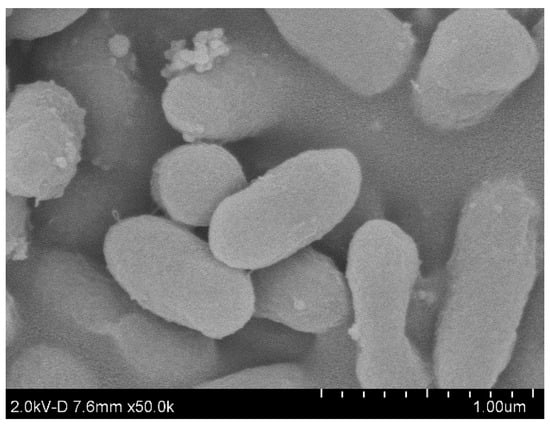
Figure 1.
Scanning electron microscope (SEM) image of the isolated strain AO-1 exposed to naphthalene.
Based on 16S rRNA sequencing, the strain AO-1 was identified as a P. aeruginosa strain, which is a PAH degrader and biosurfactant producer. The phylogenetic tree of the strain is shown in Figure 2. Numerous studies have demonstrated that P. aeruginosa can degrade a diverse range of PAHs, which highlights its remarkable adaptability and degradation potential [15,19,30,39]. According to the oil spreading test, the strain AO-1 could produce biosurfactants (Figure 3). The production of biosurfactants by these bacteria is beneficial for the degradation of PAHs, as it enhances the solubility and bioavailability of PAHs, thereby facilitating their degradation [39,40,41,42]. Therefore, the bacterium P. aeruginosa was suitable for use in the bioremediation of PAH-contaminated sites.
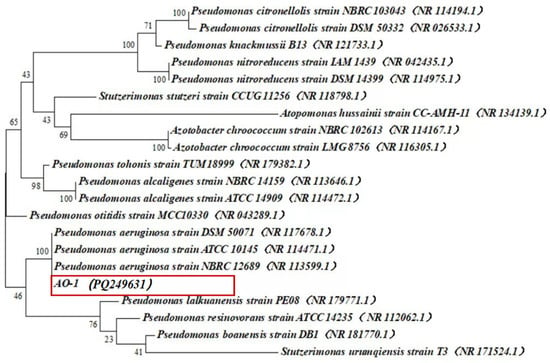
Figure 2.
Phylogenetic tree based on the 16S rDNA sequence of strain AO-1.
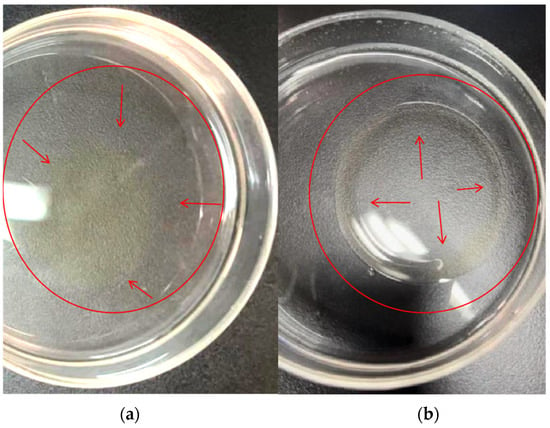
Figure 3.
(a) Oil spreading test of the crude biosurfactant of strain AO-1; (b) control with water.
3.2. Degradation of PAHs by Strain AO-1 in Single and Binary Systems
Naphthalene is the simplest PAH in terms of structure. In the current study, naphthalene was selected as the model pollutant to examine the degradation of PAHs by strain AO-1. The degradation kinetics of naphthalene by AO-1 bacterial solution are shown in Figure 4. Approximately 98% of total naphthalene was degraded by strain AO-1 within 24 h. This strain exhibited a remarkable degradation capability of naphthalene. During the degradation of naphthalene, the growth curve of strain AO-1 and bacterial dehydrogenase activity were monitored. Between 8 and 24 h, the strain underwent rapid growth in the exponential phase, reaching an OD600 value of 0.3, after which it entered a lag phase. This indicates that strain AO-1 can effectively use 50 mg/L naphthalene as a carbon source for growth. During this period, approximately 97.8% of naphthalene was removed. This finding was consistent with the growth curve of the strain. The degradation of PAHs is based on the oxidation process, in which hydrogen atoms from PAH are transferred to a hydrogen acceptor in a reaction catalyzed by a dehydrogenase [43]. The dehydrogenase activity of microorganisms may reflect the oxidative degradation of organic pollutants [44]. As shown in Figure 4, the dehydrogenase activity increased significantly between 8 and 24 h. Furthermore, there was a positive correlation between dehydrogenase activity, bacterial growth rate, and naphthalene degradation.
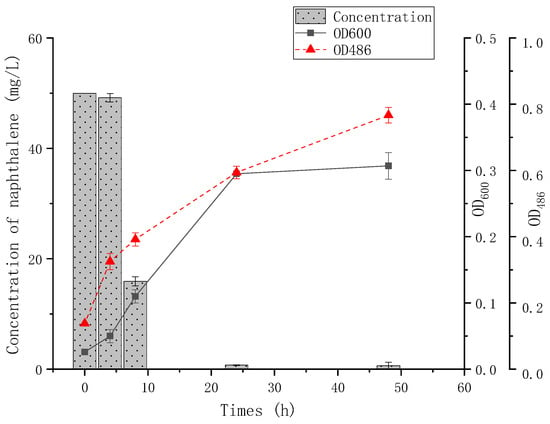
Figure 4.
Degradation of naphthalene by strain AO-1 in a culture containing naphthalene as the sole carbon source. OD600 and OD486 were used to represent the growth and dehydrogenase activity of the strain, respectively.
Figure 5 shows the degradation patterns of PAHs, including fluorene, phenanthrene, anthracene, and pyrene, in both single and binary substrate systems with naphthalene. In the single substrate system, it appears that fluorene, phenanthrene, anthracene, and pyrene cannot readily metabolize, with removal rates of 14.33%, 17.25%, 6.61%, and 4.47%, respectively. Nevertheless, when naphthalene is added as a cometabolite carbon source, the corresponding removal ratios significantly increased to approximately 72.08%, 100.00%, 15.63%, and 6.63%, whereas naphthalene was removed at a rate comparable to that observed in the single substrate system. This demonstrates the capability of the AO-1 strain to utilize fluorene, phenanthrene, anthracene, and pyrene as the sole carbon source.
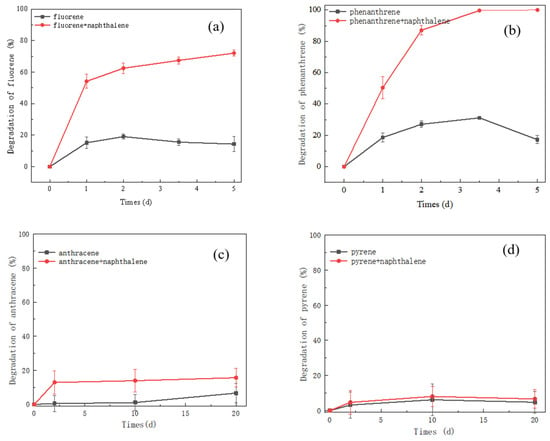
Figure 5.
Degradation profiles of (a) fluorene, (b) phenanthrene, (c) anthracene, and (d) pyrene by strain AO-1 in both single and binary degradation systems. The experimental conditions were as follows: initial pH of 8, temperature of 30 °C, concentration of 50 mg/L for each PAH, and reaction time of 5 days for fluorene and phenanthrene and 20 days for anthracene and pyrene.
The marked enhancement in microbial degradation facilitated by naphthalene may be attributed to several aspects. First, as shown in Figure 4, the bacterial mass gradually increased, achieving an OD600 value of ~0.3 in the single substrate experiment; however, in the dual-substrate degradation system, the strain grew rapidly within 24 h, achieving an OD600 value of approximately 0.4 (Figure 6). As a carbon source, naphthalene does not induce a dioxin phenomenon. Naphthalene and other PAHs were utilized simultaneously. Naphthalene accelerated the growth of the degrader and generated high biomass. Thus, high levels of metabolite enzymes were produced to catalyze the removal of PAHs, as shown in Figure 7. Simultaneously, the increased biomass reduces the concentration of pollutants adsorbed by the bacterial membrane, which decreases the toxicity of PAHs on the bacteria. This allows rapid growth of the strain and augments the degradation of the pollutants. In addition, this strain is a biosurfactant producer, enabling the secretion of a greater amount of surfactants during the growth phase. This, in turn, facilitated the dissolution of pollutants and enhanced the subsequent mass transfer to microbial cells, thereby enhancing their bioavailability [29,39,45]. Surfactant production enhances the dissolution of PAHs and increases their concentrations in the medium. However, this process may inhibit the degradation of PAHs because of the high concentration of PAHs present in the system [46].
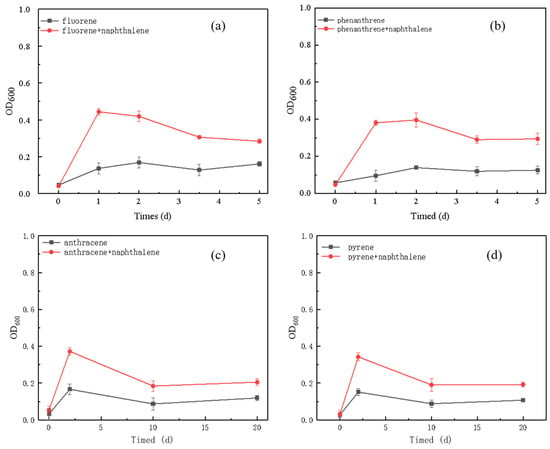
Figure 6.
Growth curve of strain AO-1 in both single and binary systems with the individual substrates: (a) fluorene, (b) phenanthrene, (c) anthracene, and (d) pyrene. The experimental conditions were as follows: an initial pH of 8, temperature of 30 °C, concentration of 50 mg/L for each PAH, and reaction time of 5 days for fluorene and phenanthrene and 20 days for anthracene and pyrene.
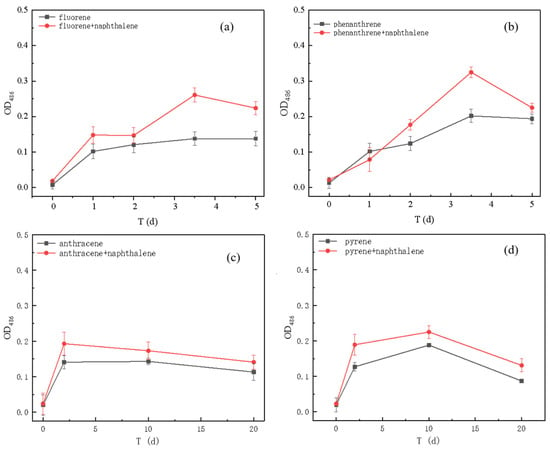
Figure 7.
Dehydrogenase activity of strain AO-1 in both single and binary degradation systems with individual substrates: (a) fluorene, (b) phenanthrene, (c) anthracene, and (d) pyrene. The experimental conditions were as follows: an initial pH of 8, temperature of 30 °C, concentration of 50 mg/L for each PAH, and reaction times of 5 days for fluorene and phenanthrene and 20 days for anthracene and pyrene.
The order of PAH degradation by strain AO-1 was as follows: naphthalene, phenanthrene, fluorene, anthracene, and pyrene. The biodegradation of PAHs was closely related to the structure and bioavailability of the pollutants. Although both fluorene and phenanthrene belong to the three -ring PAH category, fluorene poses a greater degradation because of its unique five-ring fused configuration located between two benzene rings [47]. Among fluorene, phenanthrene, and anthracene, anthracene exhibited the highest resistance to biodegradation. This can be attributed to its linear three-ring structure in contrast to the angular configuration of phenanthrene [48]. As three -ring PAHs and isomers, phenanthrene and anthracene exhibit distinct solubility behaviors in water. Based on a previous study, at 25 °C, the solubility of phenanthrene (1.15 mg/L) was greater than that of anthracene (0.04 mg/L), which facilitates its use by microorganisms [49]. Furthermore, the degradation complexity of PAHs escalates with an increase in the number of benzene rings. Pyrene, which is a four-ring PAH, exhibits increased hydrophobicity and toxicity compared with the three -ring PAHs, thereby complicating its degradation process. This is consistent with the findings of other reports. For example, Sharma et al. reported the degradation rates of fluorene, phenanthrene, anthracene, and pyrene by mixed strains at 75%, 67.8%, 52.2%, and 39.2% over 7 days [50]. Zhang evaluated the degradation characteristics of PAHs by P. aeruginosa DQ8 and revealed that three -ring PAHs were markedly degraded, whereas four-ring PAHs showed greater resistance to degradation [46]. Biodegraders preferentially utilize less complex compounds, with the degradation rate decreasing with an increase in the number of benzene rings [15,29].
3.3. Degradation of PAHs by Strain AO-1 Using Different Carbon Sources
In the binary degradation system, naphthalene promoted the microbial removal of four PAHs. This study examined the effect of naphthalene as a carbon source on the degradation of a PAH mixture. As carbon is a fundamental energy source for microbial growth and metabolic activity, differences in the type and quantity of carbon sources can significantly modulate microbial metabolic processes [51]. In the current study, degradation of a PAH mixture (fluoranthene, phenanthrene, anthracene, and pyrene) supplemented with naphthalene was evaluated. The use of naphthalene was compared with that of glucose and SA as cosubstrate carbon sources (Figure 8). Notably, a previous study demonstrated the ability of glucose to enhance the degradation rate of naphthalene by P. putida CSV86, underscoring its potential role in optimizing the degradation process [52]. The degradation rates of a PAH mixture without the addition of carbon were lower than the desired degradation rate observed for single compounds. This is because increasing structural complexity of PAHs and total concentration of multiple PAHs induce greater toxicity to cells [24], in addition to inter-PAH chemical interference [3]. For each experimental group, the degradation efficiency of the four PAHs varied. Strain AO-1 preferentially utilized fluorene and phenanthrene, whereas only a small quantity of anthracene and pyrene was degraded. With the increase in the number of benzene rings, the solubility of PAHs gradually declined, resulting in poorer bioavailability. In addition, each PAH exhibited differences in removal efficiency among the four degradation groups. When naphthalene was used as a carbon source, the degradation rate of PAHs was higher than that of glucose or SA (Figure 8).
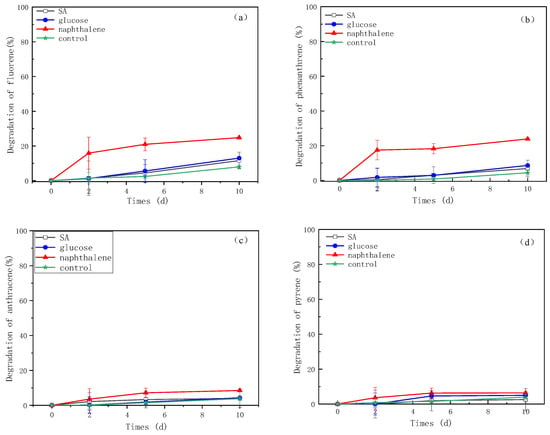
Figure 8.
Degradation of (a) fluorene, (b) phenanthrene, (c) anthracene, and (d) pyrene in a mixture by strain AO-1 using different carbon sources. The experimental conditions were as follows: an initial pH of 8, temperature of 30 °C, concentration of 50 mg/L for each PAH, and reaction time of 10 days.
After 10 days of degradation, the group utilizing naphthalene as a carbon source exhibited notably higher degradation rates of fluorene (24.81%), phenanthrene (23.86%), anthracene (8.46%), and pyrene (6.39%), which surpassed the rates achieved using glucose and SA as well as those achieved in the absence of an additional carbon source. This finding highlights the effectiveness of naphthalene in promoting the degradation of mixed PAHs by strain AO-1. The naphthalene-treated group exhibited the highest dehydrogenase activity and bacterial biomass during the degradation process (Figure 9). Dehydrogenases are intracellular oxidoreductases that play an important role in the initial oxidation of PAHs [43,53]. There was a positive correlation between bacterial titer, dehydrogenase activity, and degradation efficiency of PAHs.
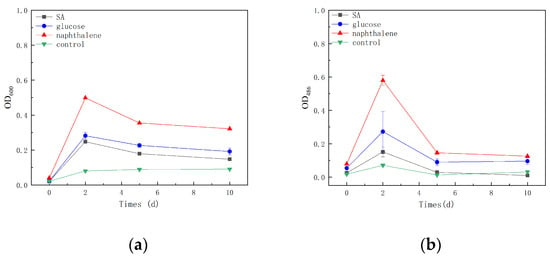
Figure 9.
(a) Biomass based on OD600 values and (b) dehydrogenase activity of strain AO-1 in the degradation of a PAH mixture with different carbon sources. The experimental conditions were as follows: an initial pH of 8, temperature of 30 °C, concentration of 50 mg/L for each PAH, and reaction time of 10 days.
Naphthalene exerted a synergistic effect on the degradation of the four PAHs. It may augment bacterial biomass and stimulate the enzymatic cascade responsible for PAH degradation. Previous studies have reported comparable results, wherein the addition of low molecular weight (LMW) PAHs enhanced the degradation of high molecular weight (HMW) PAHs [31]. The addition of phenanthrene and naphthalene as cometabolites significantly enhanced the degradation of HMW PAHs, particularly pyrene, by Nitratireductor aquimarinus, Marinobacter gudaonensis, and Pseudonocardia carboxydivorans [29]. No significant effect was observed on the degradation of PAHs when glucose and SA were used as cometabolite carbon sources. Typically, the addition of a cometabolite substrate enhances bioremediation by promoting the growth of biodegrading microorganisms; however, if the introduced carbon source is preferentially utilized, it may inhibit the degradation of the target pollutant until it is exhausted [30].
3.4. Comparative Transcriptional Analysis of Strain AO-1 Using Naphthalene/Glucose as a Carbon Source
Transcriptome sequencing was performed to identify alterations in gene expression in response to additional carbon sources—naphthalene and glucose—and elucidate the underlying mechanisms of biostimulation in strain AO-1. The complete genome of AO-1 was sequenced using GCF_000006765.1 as the reference gene. High-quality, clean reads were extracted from the sequencing data. The proportions of uniquely mapped reads were 92.89% (Naph1) and 91.47% (Glucose1) of the total reads (Table 1). The Q30 value, indicative of a base sequencing error rate of 0.1%, exceeded 94.63%, indicating excellent sequencing quality.

Table 1.
RNA sequencing data of two samples: naphthalene and glucose.
3.4.1. Analysis of DEGs
A total of 5708 genes were obtained from the transcriptome data of P. aeruginosa strain AO-1. Among these, 2185 genes were significantly differentially expressed, of which the expression of 106 genes was upregulated and that of 2079 genes was downregulated. A volcano plot of the significant DEGs is shown in Figure 10.
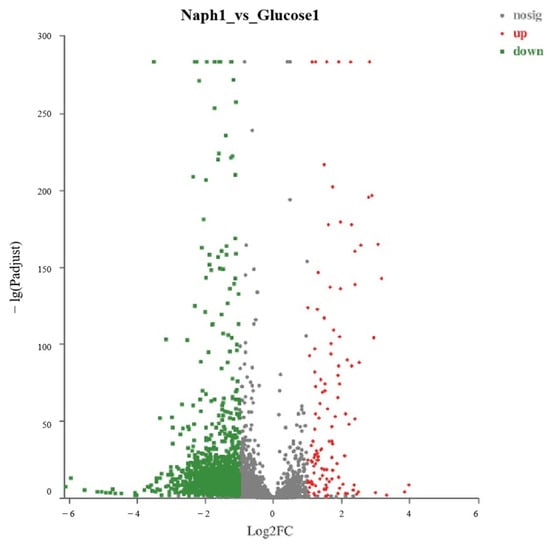
Figure 10.
Volcano plot showing DEGs. Red and green dots represent significant upregulation and downregulation of gene expression, respectively, and gray dots represent no significant difference. The criterion for considering a significant difference was an FDR of <0.05 and a difference of more than twofold.
3.4.2. GO Enrichment Analysis of DEGs
Based on GO analysis, the DEGs were classified into three main categories: biological process, molecular function, and cellular component. To obtain the complete gene functional information of strain AO-1, GO enrichment analysis was conducted at a secondary level (Figure 11). A total of 1890 DEGs were associated with biological processes and regulation of DNA transcription and transmembrane transport. Within the cellular component category, the DEGs were distributed into integral membrane and plasma membrane components. Some of these gene products, which are involved in membrane transport, play an important role in the recognition of PAHs by facilitating their transmembrane transport and subsequent intracellular metabolism. In the molecular function category, the DEGs were assigned to numerous categories, including ATP-binding, transmembrane transporter activity, and associated catalytic functions. This finding is consistent with the established response of P. aeruginosa to fluoranthene stress [54]. Because PAHs are lipophilic and dehydrogenases and other essential enzymes are located intracellularly, transportation of PAHs across the cell membrane prior to their degradation is essential [5]. Consequently, the transmembrane transport process emerged as an important step in the degradation of PAHs. Overall, during the degradation of PAHs by strain AO-1, the DEGs were assigned to substrate transport, enzyme catalytic activity, and biodegradation metabolism.
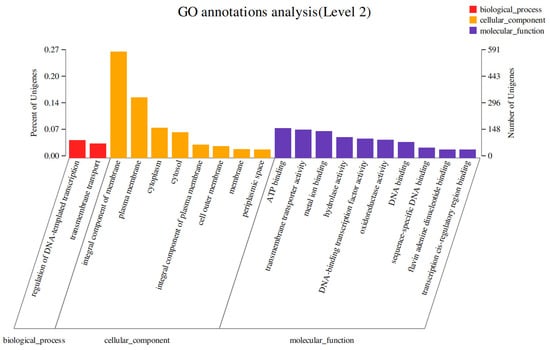
Figure 11.
GO annotation of DEGs in secondary level.
3.4.3. KEGG Enrichment Analysis of DEGs
To identify potential metabolic pathways for each DEG, all DEGs were subjected to KEGG analysis. Consequently, 1279 DEGs were assigned to 40 KEGG pathways. The pathways were classified into the following six categories: genetic information processing, environmental information processing, cellular processes, metabolism, human diseases, and organismal systems (Figure 12).
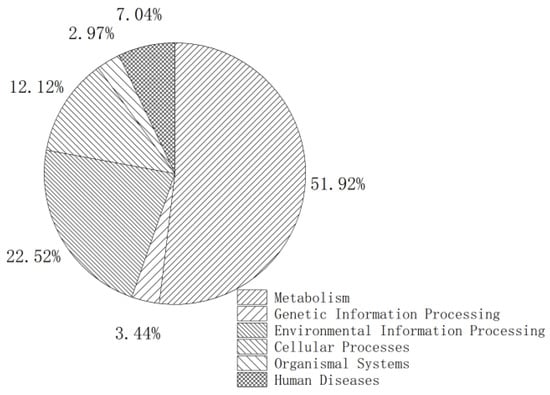
Figure 12.
KEGG classification of DEGs in A class.
Based on KEGG annotation data, 664 DEGs were annotated to the metabolic pathway, constituting approximately 51.92% (664/1279) of the total DEGs (Figure 13). Among these DEGs, 137 belonged to the “amino acid metabolism” category. In addition, 89 DEGs were implicated in carbohydrate metabolism, whereas 38 were associated with xenobiotics biodegradation and metabolism (Figure 14). These DEGs are primarily involved in the metabolism of benzene ring structures and include various pathways, such as naphthalene degradation, benzoate degradation, caprolactam degradation, aminobenzoate degradation, xylene degradation, PAH degradation, and styrene degradation. This suggests that PAH degradation by strain AO-1 is closely associated with these pathways. Several significant DEGs related to the degradation pathway of PAHs are listed in Table 2. The dioxygenase- and dehydrogenase-related genes were also significantly differentially expressed, consistent with the findings of previous reports on the degradation of PAHs [20,55,56].
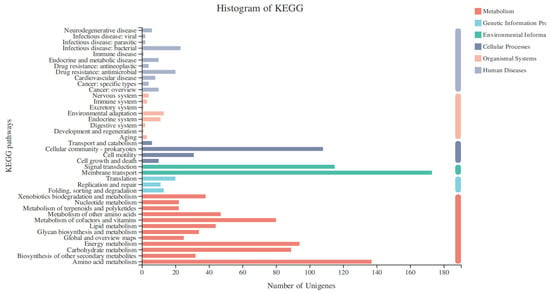
Figure 13.
KEGG classification of DEGs in B class.
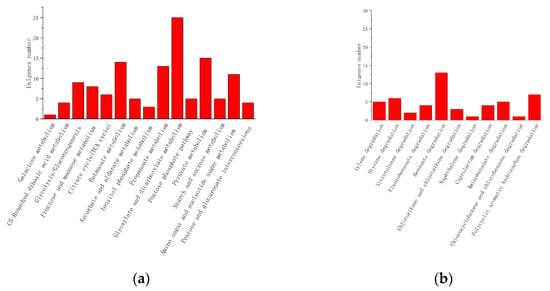
Figure 14.
Gene enrichment analysis of different KEGG pathways: (a) Carbohydrate metabolism; (b) Xenobiotics biodegradation and metabolism.

Table 2.
DEGs identified via transcriptomics analysis of Pseudomonas aeruginosa under naphthalene stress.
The DEGs were predominantly distributed in various pathways, including energy metabolism, membrane transport, signal transduction pathway, ABC transporters, and two-component system. Typically, intracellular degradation and transport of PAHs across the cell membrane occur during the initial stage in bacteria [20]. ABC proteins are involved in the transport of substances across cell membranes [16,57]. Differential expression of ABC transport–related genes was observed in this study. These genes likely influence the mass transfer of PAHs through the membrane, thereby affecting the biodegradation rate and efficiency [16]. A similar finding was reported in a PAH degradation study, revealing the upregulation of ABC genes associated with substance transport [58]. Interestingly, a large number of DEGs were involved in the biodegradation of PAHs, constituting a relatively high proportion of the total DEGs. For instance, all 89 carbon metabolism genes exhibited significant differential expression (Figure 15). The DEGs assigned to primary metabolic pathways were identified, and the results indicated that pathways such as ABC transporters, amino acid metabolism, two-component system, and carbon metabolism are related to substrate binding and transport, signal transduction, and gene expression regulation.
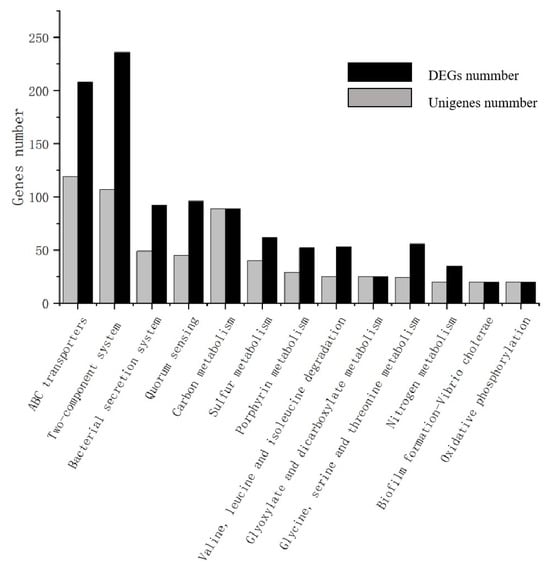
Figure 15.
Number of unigenes and DEGs in the primary KEGG pathways.
Based on the combined results of degradation profiling, enzyme activity assessments, and transcriptomic analyses, the increased removal of PAHs in the presence of naphthalene may be partially attributed to the enhancement of PAH metabolic activity within strain AO-1 as well as the augmentation of membrane transportation-related functions pertaining to the transfer of PAHs to bacteria.
4. Conclusions
In this study, the P. aeruginosa strain AO-1 capable of degrading PAHs was successfully isolated from a coking-contaminated site. The effect of naphthalene supplementation as a cometabolite carbon source on the degradation of other PAHs was examined. The results indicated that naphthalene positively affected the biodegradation of PAHs by accelerating strain growth and enhancing the associated enzymatic activity. The degradation rates of fluorene, phenanthrene, anthracene, and pyrene increased from 14.33%, 17.25%, 6.61%, and 4.47% to 72.08%, 100%, 15.63%, and 6.63%, respectively. Transcriptomic profiling revealed that naphthalene promoted transmembrane transport capabilities and metabolic processes. These findings not only validate the effectiveness of naphthalene but also provide molecular insights into the biostimulation of PAHs using naphthalene. Moreover, the findings of this study provide theoretical and experimental support for the in situ remediation of PAH-contaminated soil and water.
Author Contributions
Conceptualization, B.L.; methodology, H.L., X.L. and L.T.; validation, H.L., X.L., L.H. and J.Y.; formal analysis, J.Y. and L.K.; investigation, L.H.; resources, H.L. and X.L.; data curation, L.H.; writing—original draft preparation, B.L.; writing—review and editing, T.Q.; visualization, X.L.; supervision T.Q.; project administration B.L.; funding acquisition T.Q. All authors have read and agreed to the published version of the manuscript.
Funding
This research was funded by the Fundamental Research Program of Shanxi Province grant number 20210302123119 and the APC was funded by the Horizontal Scientific Research Funds of Taiyuan University of Technology, grant number RH2200002532, RH2300002821.
Data Availability Statement
Data will be made available on request.
Conflicts of Interest
Author Hulong Liu and Li Han were employed by the company Shanxi Guoxin Caregeno Biotechnology Co. Author Jing Yang was employed by the company Shanxi Transportation Holding Ecological Environment Co., Ltd. The remaining authors declare that the research was conducted in the absence of any commercial or financial relationships that could be construed as a potential conflict of interest. The funders had no role in the design of the study; in the collection, analyses, or interpretation of data; in the writing of the manuscript; or in the decision to publish the results.
References
- Vijayanand, M.; Ramakrishnan, A.; Subramanian, R.; Issac, P.K.; Nasr, M.; Khoo, K.S.; Rajagopal, R.; Greff, B.; Azelee, N.I.W.; Jeon, B.-H.; et al. Polyaromatic hydrocarbons (PAHs) in the water environment: A review on toxicity, microbial biodegradation, systematic biological advancements, and environmental fate. Environ. Res 2023, 227, 115716. [Google Scholar] [CrossRef] [PubMed]
- Gong, G.Y.; Wu, S.M. Degradation of polycyclic aromatic hydrocarbons in oil deodorizer distillates: Kinetics, degradation product identification and toxicity. Int. Biodeterior. Biodegrad. 2024, 187, 105718. [Google Scholar] [CrossRef]
- Singh, S.K.S.; Haritash, A.K. Bacterial degradation of mixed-PAHs and expression of PAH-catabolic genes. World J. Microbiol. Biotechnol. 2022, 39, 47. [Google Scholar] [CrossRef]
- Sun, K.; Song, Y.; He, F.; Jing, M.; Tang, J.; Liu, R. A review of human and animals exposure to polycyclic aromatic hydrocarbons: Health risk and adverse effects, photo-induced toxicity and regulating effect of microplastics. Sci. Total Environ. 2021, 773, 145403. [Google Scholar] [CrossRef] [PubMed]
- Chen, W.; Teng, Y.; Ren, W.; Luo, Y.; Yu, Y. A highly effective polycyclic aromatic hydrocarbon-degrading bacterium, Paracoccus sp. HPD-2, shows opposite remediation potential in two soil types. Pedosphere 2022, 32, 673–685. [Google Scholar] [CrossRef]
- Zhang, B.; Xu, W.; Ma, Y.; Gao, X.; Ming, H.; Jia, J. Effects of bioaugmentation by isolated Achromobacter xylosoxidans BP1 on PAHs degradation and microbial community in contaminated soil. J. Environ. Manag. 2023, 334, 117491. [Google Scholar] [CrossRef]
- Wartell, B.; Boufadel, M.; Rodriguez-Freire, L. An effort to understand and improve the anaerobic biodegradation of petroleum hydrocarbons: A literature review. Int. Biodeterior. Biodegrad. 2021, 157, 105156. [Google Scholar] [CrossRef]
- Santaren, K.C.F.; Lopes, E.S.; Rocha, H.G.V.; Domingos, A.C.A.; Jurelevicius, D.A.; Seldin, L. Naphthalene-Degrading Bacteria with Potential for Remediating Marine Environments. Polycycl. Aromat. Compd. 2024, 1–11. [Google Scholar] [CrossRef]
- Cheng, L.; Wang, Y.; Cai, Z.; Liu, J.; Yu, B.; Zhou, Q. Phytoremediation of petroleum hydrocarbon-contaminated saline-alkali soil by wild ornamental Iridaceae species. Int. J. Phytoremediation 2017, 19, 300–308. [Google Scholar] [CrossRef]
- Peixoto, R.S.; Vermelho, A.B.; Rosado, A.S. Petroleum-degrading enzymes: Bioremediation and new prospects. Enzym. Res. 2011, 2011, 475193. [Google Scholar] [CrossRef]
- Sana, B. Bioresources for control of environmental pollution. Adv. Biochem. Eng. Biotechnol. 2015, 147, 137–183. [Google Scholar] [CrossRef]
- Chen, Z.; Hu, H.; Xu, P.; Tang, H. Soil bioremediation by Pseudomonas brassicacearum MPDS and its enzyme involved in degrading PAHs. Sci. Total Environ. 2022, 813, 152522. [Google Scholar] [CrossRef]
- Liu, S.S.; Huang, H.J.; Tu, Z.H. Phenanthrene Degradation by Sphingobium sp. PM1B in Soil Containing Polyethylene Microplastics: Effects and Mechanisms. Water Air Soil Pollut. 2024, 235, 8. [Google Scholar] [CrossRef]
- Du, J.Q.; Jia, T.; Liu, J.X.; Chai, B.F. Relationships among protozoa, bacteria and fungi in polycyclic aromatic hydrocarbon-contaminated soils. Ecotoxicol. Environ. Saf. 2024, 270, 115904. [Google Scholar] [CrossRef] [PubMed]
- Ansari, F.; Ahmad, A.; Rafatullah, M. Review on bioremediation technologies of polycyclic aromatic hydrocarbons (PAHs) from soil: Mechanisms and future perspective. Int. Biodeterior. Biodegrad. 2023, 179, 105582. [Google Scholar] [CrossRef]
- Yuan, K.; Xie, X.; Wang, X.; Lin, L.; Yang, L.; Luan, T.; Chen, B. Transcriptional response of Mycobacterium sp. strain A1-PYR to multiple polycyclic aromatic hydrocarbon contaminations. Environ. Pollut. 2018, 243, 824–832. [Google Scholar] [CrossRef]
- Subashchandrabose, S.R.; Venkateswarlu, K.; Naidu, R.; Megharaj, M. Biodegradation of high-molecular weight PAHs by Rhodococcus wratislaviensis strain 9: Overexpression of amidohydrolase induced by pyrene and BaP. Sci. Total Environ. 2019, 651 Pt 1, 813–821. [Google Scholar] [CrossRef]
- Yessentayeva, K.; Reinhard, A.; Berzhanova, R.; Mukasheva, T.; Urich, T.; Mikolasch, A. Bacterial crude oil and polyaromatic hydrocarbon degraders from Kazakh oil fields as barley growth support. Appl. Microbiol. Biotechnol. 2024, 108, 189. [Google Scholar] [CrossRef]
- Kuppusamy, S.; Thavamani, P.; Venkateswarlu, K.; Lee, Y.B.; Naidu, R.; Megharaj, M. Remediation approaches for polycyclic aromatic hydrocarbons (PAHs) contaminated soils: Technological constraints, emerging trends and future directions. Chemosphere 2017, 168, 944–968. [Google Scholar] [CrossRef]
- Zhang, X.; Liu, X.; Lin, S.; Zhu, X.; Zhang, Z.; Shen, B.; Zhou, S. Fulvic acid enhancing pyrene biodegradation by immobilized Stenotrophomonas maltophilia: Effect and mechanism. Bioresour. Technol. 2024, 403, 130857. [Google Scholar] [CrossRef]
- Zou, X.; Su, Q.; Yi, Q.; Guo, L.; Chen, D.; Wang, B.; Li, Y.; Li, J. Determining the degradation mechanism and application potential of benzopyrene-degrading bacterium Acinetobacter XS-4 by screening. J. Hazard Mater. 2023, 456, 131666. [Google Scholar] [CrossRef] [PubMed]
- Yang, H.; Qian, Z.; Liu, Y.; Yu, F.; Huang, T.; Zhang, B.; Peng, T.; Hu, Z. Comparative genomics reveals evidence of polycyclic aromatic hydrocarbon degradation in the moderately halophilic genus Pontibacillus. J. Hazard. Mater. 2024, 462. [Google Scholar] [CrossRef] [PubMed]
- Dhar, K.; Subashchandrabose, S.R.; Venkateswarlu, K.; Krishnan, K.; Megharaj, M. Anaerobic Microbial Degradation of Polycyclic Aromatic Hydrocarbons: A Comprehensive Review. Rev. Environ. Contam. Toxicol. 2020, 251, 25–108. [Google Scholar] [CrossRef] [PubMed]
- Imam, A.; Suman, S.K.; Vasavdutta, S.; Chatterjee, S.; Vempatapu, B.P.; Ray, A.; Kanaujia, P.K. Degradation of multiple PAHs and co-contaminants by microbial consortia and their toxicity assessment. Biodegradation 2024, 35, 299–313. [Google Scholar] [CrossRef]
- Bourguignon, N.; Irazusta, V.; Isaac, P.; Estévez, C.; Maizel, D.; Ferrero, M.A. Identification of proteins induced by polycyclic aromatic hydrocarbon and proposal of the phenanthrene catabolic pathway in Amycolatopsis tucumanensis DSM 45259. Ecotoxicol. Environ. Saf. 2019, 175, 19–28. [Google Scholar] [CrossRef]
- Khandelwal, A.; Nain, L.; Singh, S.B.; Varghese, E.; Sharma, A.; Gupta, S.; Singh, N. Bacteria and fungi mediated degradation of poly aromatic hydrocarbons and effect of surfactant Tween-80. Int. J. Environ. Anal. Chem. 2024, 104, 27–42. [Google Scholar] [CrossRef]
- Mehetre, G.T.; Dastager, S.G.; Dharne, M.S. Biodegradation of mixed polycyclic aromatic hydrocarbons by pure and mixed cultures of biosurfactant producing thermophilic and thermo-tolerant bacteria. Sci. Total Environ. 2019, 679, 52–60. [Google Scholar] [CrossRef]
- Tang, L.; Yang, J.; Liu, X.; Kang, L.; Li, W.; Wang, T.; Qian, T.; Li, B. Biodegradation of phenanthrene-Cr (VI) co-contamination by Pseudomonas aeruginosa AO-4 and characterization of enhanced degradation of phenanthrene. Sci. Total Environ. 2024, 918, 170744. [Google Scholar] [CrossRef]
- Ahmad, M.; Ling, J.; Yin, J.; Chen, L.; Yang, Q.; Zhou, W.; Zhang, Y.; Huang, X.; Khan, I.; Dong, J. Evaluation of the Different Nutritional and Environmental Parameters on Microbial Pyrene Degradation by Mangrove Culturable Bacteria. Int. J. Mol. Sci. 2023, 24, 8282. [Google Scholar] [CrossRef]
- Lee, K.; Park, J.-W.; Ahn, I.-S. Effect of additional carbon source on naphthalene biodegradation by Pseudomonas putida G7. J. Hazard. Mater. 2003, 105, 157–167. [Google Scholar] [CrossRef]
- Haritash, A.K.; Kaushik, C.P. Biodegradation aspects of polycyclic aromatic hydrocarbons (PAHs): A review. J. Hazard Mater. 2009, 169, 1–15. [Google Scholar] [CrossRef] [PubMed]
- Stringfellow, W.T.; Aitken, M.D. Competitive metabolism of naphthalene, methylnaphthalenes, and fluorene by phenanthrene-degrading pseudomonads. Appl. Environ. Microbiol. 1995, 61, 357–362. [Google Scholar] [CrossRef]
- Giovanella, P.; Taketani, R.G.; Gil-Solsona, R.; Saldanha, L.L.; Naranjo, S.B.E.; Sancho, J.V.; Portolés, T.; Andreote, F.D.; Rodríguez-Mozaz, S.; Barceló, D.; et al. A comprehensive study on diesel oil bioremediation under microcosm conditions using a combined microbiological, enzymatic, mass spectrometry, and metabarcoding approach. Environ. Sci. Pollut. Res. 2023, 30, 101250–101266. [Google Scholar] [CrossRef] [PubMed]
- Dean-Ross, D.; Moody, J.; Cerniglia, C.E. Utilization of mixtures of polycyclic aromatic hydrocarbons by bacteria isolated from contaminated sediment. FEMS Microbiol. Ecol. 2002, 41, 1–7. [Google Scholar] [CrossRef]
- Tsai, J.C.; Kumar, M.; Lin, J.G. Anaerobic biotransformation of fluorene and phenanthrene by sulfate-reducing bacteria and identification of biotransformation pathway. J. Hazard Mater. 2009, 164, 847–855. [Google Scholar] [CrossRef]
- Kiran, G.S.; Hema, T.; Gandhimathi, R.; Selvin, J.; Thomas, T.A.; Ravji, T.R.; Natarajaseenivasan, K. Optimization and production of a biosurfactant from the sponge-associated marine fungus Aspergillus ustus MSF3. Colloids Surf. B Biointerfaces 2009, 73, 250–256. [Google Scholar] [CrossRef]
- Lavania, M.; Cheema, S.; Sarma, P.M.; Mandal, A.K.; Lal, B. Biodegradation of asphalt by Garciaella petrolearia TERIG02 for viscosity reduction of heavy oil. Biodegradation 2012, 23, 15–24. [Google Scholar] [CrossRef]
- Young Kevin, D. The Selective Value of Bacterial Shape. Microbiol. Mol. Biol. Rev. 2006, 70, 660–703. [Google Scholar] [CrossRef] [PubMed]
- Sun, S.; Wang, Y.; Zang, T.; Wei, J.; Wu, H.; Wei, C.; Qiu, G.; Li, F. A biosurfactant-producing Pseudomonas aeruginosa S5 isolated from coking wastewater and its application for bioremediation of polycyclic aromatic hydrocarbons. Bioresour. Technol. 2019, 281, 421–428. [Google Scholar] [CrossRef]
- Patowary, R.; Patowary, K.; Kalita, M.C.; Deka, S.; Borah, J.M.; Joshi, S.J.; Zhang, M.; Peng, W.; Sharma, G.; Rinklebe, J.; et al. Biodegradation of hazardous naphthalene and cleaner production of rhamnolipids—Green approaches of pollution mitigation. Environ. Res. 2022, 209, 112875. [Google Scholar] [CrossRef]
- Morikawa, M.; Hirata, Y.; Imanaka, T. A study on the structure–function relationship of lipopeptide biosurfactants. Biochim. et Biophys. Acta (BBA)—Mol. Cell Biol. Lipids 2000, 1488, 211–218. [Google Scholar] [CrossRef]
- Wang, K.; Zhang, J.M.; Li, M.S.; Zhu, S.T.; Pan, T. From Antagonism to Enhancement: Triton X-100 Surfactant Affects Phenanthrene Interfacial Biodegradation by Mycobacteria through a Shift in Uptake Mechanisms. Langmuir 2024, 40, 11106–11115. [Google Scholar] [CrossRef] [PubMed]
- Zhang, X.; Chen, L.; Liu, X.; Wang, C.; Chen, X.; Xu, G.; Deng, K. Synergic degradation of diesel by Scirpus triqueter and its endophytic bacteria. Environ. Sci. Pollut. Res. 2014, 21, 8198–8205. [Google Scholar] [CrossRef] [PubMed]
- Singh, S.K.S.; Haritash, A.K. Haritash, Catabolic enzyme activity and kinetics of pyrene degradation by novel bacterial strains isolated from contaminated soil. Environ. Technol. Innov. 2021, 23, 101744. [Google Scholar] [CrossRef]
- Liang, X.; Guo, C.; Wei, Y.; Lin, W.; Yi, X.; Lu, G.; Dang, Z. Cosolubilization synergism occurrence in codesorption of PAH mixtures during surfactant-enhanced remediation of contaminated soil. Chemosphere 2016, 144, 583–590. [Google Scholar] [CrossRef]
- Zhang, Z.; Hou, Z.; Yang, C.; Ma, C.; Tao, F.; Xu, P. Degradation of n-alkanes and polycyclic aromatic hydrocarbons in petroleum by a newly isolated Pseudomonas aeruginosa DQ8. Bioresour. Technol. 2011, 102, 4111–4116. [Google Scholar] [CrossRef]
- Rentz, J.A.; Alvarez, P.J.; Schnoor, J.L. Repression of Pseudomonas putida phenanthrene-degrading activity by plant root extracts and exudates. Environ. Microbiol. 2004, 6, 574–583. [Google Scholar] [CrossRef]
- Jiang, Y.; Zhang, Z.; Zhang, X. Co-biodegradation of pyrene and other PAHs by the bacterium Acinetobacter johnsonii. Ecotoxicol. Environ. Saf. 2018, 163, 465–470. [Google Scholar] [CrossRef]
- Gupta, S.; Pathak, B.; Fulekar, M.H. Molecular approaches for biodegradation of polycyclic aromatic hydrocarbon compounds: A review. Rev. Environ. Sci. Bio/Technol. 2015, 14, 241–269. [Google Scholar] [CrossRef]
- Sharma, A.; Singh, S.B.; Sharma, R.; Chaudhary, P.; Pandey, A.K.; Ansari, R.; Vasudevan, V.; Arora, A.; Singh, S.; Saha, S.; et al. Enhanced biodegradation of PAHs by microbial consortium with different amendment and their fate in in-situ condition. J. Environ. Manag. 2016, 181, 728–736. [Google Scholar] [CrossRef]
- Xia, M.; Fu, D.; Chakraborty, R.; Singh, R.P.; Terry, N. Enhanced crude oil depletion by constructed bacterial consortium comprising bioemulsifier producer and petroleum hydrocarbon degraders. Bioresour. Technol. 2019, 282, 456–463. [Google Scholar] [CrossRef]
- Basu, A.; Apte, S.K.; Phale, P.S. Preferential utilization of aromatic compounds over glucose by Pseudomonas putida CSV86. Appl. Environ. Microbiol. 2006, 72, 2226–2230. [Google Scholar] [CrossRef]
- Singh, S.K.S.; Haritash, A.K. Catabolic enzyme activities during biodegradation of three-ring PAHs by novel DTU-1Y and DTU-7P strains isolated from petroleum-contaminated soil. Arch. Microbiol. 2021, 203, 3101–3110. [Google Scholar] [CrossRef] [PubMed]
- Li, Y.-P.; Tian, Y.-X.; Hao, Z.-D.; Ma, Y.-L. Transcriptomic analysis of Pseudomonas aeruginosa DN1 upon degradation of fluoranthene. Microbiol. China 2020, 47, 54–65. [Google Scholar] [CrossRef]
- Zafra, G.; Taylor, T.D.; Absalón, A.E.; Cortés-Espinosa, D.V. Comparative metagenomic analysis of PAH degradation in soil by a mixed microbial consortium. J. Hazard. Mater. 2016, 318, 702–710. [Google Scholar] [CrossRef]
- Fan, K.; Feng, Q.; Li, K.; Lin, J.; Wang, W.; Cao, Y.; Gai, H.; Song, H.; Huang, T.; Zhu, Q.; et al. The metabolism of pyrene by a novel Altererythrobacter sp. with in-situ co-substrates: A mechanistic analysis based on pathway, genomics, and enzyme activity. Chemosphere 2022, 307, 135784. [Google Scholar] [CrossRef] [PubMed]
- Gonzalez, D.; Richez, M.; Bergonzi, C.; Chabriere, E.; Elias, M. Crystal structure of the phosphate-binding protein (PBP-1) of an ABC-type phosphate transporter from Clostridium perfringens. Sci. Rep. 2014, 4, 6636. [Google Scholar] [CrossRef] [PubMed]
- Zhou, H.; Li, X.; Hu, B.; Wu, M.; Zhang, Y.; Yi, X.; Liu, Y. Assembly of fungal mycelium-carbon nanotube composites and their application in pyrene removal. J. Hazard. Mater. 2021, 415, 125743. [Google Scholar] [CrossRef]
Disclaimer/Publisher’s Note: The statements, opinions and data contained in all publications are solely those of the individual author(s) and contributor(s) and not of MDPI and/or the editor(s). MDPI and/or the editor(s) disclaim responsibility for any injury to people or property resulting from any ideas, methods, instructions or products referred to in the content. |
© 2024 by the authors. Licensee MDPI, Basel, Switzerland. This article is an open access article distributed under the terms and conditions of the Creative Commons Attribution (CC BY) license (https://creativecommons.org/licenses/by/4.0/).